It’s been a while, I know. I was browsing around the net as usual and came across something that was at the back of my mind for a while now and it was graphically illustrated convincingly so I thought it would be a great excuse to break radio silence here. Which, by the way, is not intentional. I never made a decision to scale back posting or anything like that. I will try to get more active again because I do often have a lot to say about a lot of things.
Anyway, as usual, a digression (or two), even though I haven’t even mentioned the main topic.
Brexit
It’s a little late to be talking about this, but this is what I was thinking throughout this ‘panic’. Of course, like everyone else, I was terrified when the vote came. I never really put much thought to it either way, but when I saw the markets going nuts, I was terrified.
But then I thought about it for a second. OK, so the Brits want out. Fine. Capex and business might slow down for a while as there is uncertainty that wasn’t there before; can we build a plant in Britain or not? Do we have to move to continental Europe? Will banks have to move or not?
Two things came to mind when thinking about this. First of all, if you look at all the major tops, markets rarely make a top on some specific news like this. This just felt like fiscal cliff and other mini-panics we’ve seen in the recent past.
I couldn’t imagine, that 20 years from now, that we would be sitting here and looking at a long term S&P 500 chart and go, “see here? That’s the high of 2016. Things were OK until Brexit and that was it. It was all over…”.
No matter how hard I tried to imagine that, I couldn’t.
Second of all, yes there is short term uncertainty, just like the fiscal cliff, end of QE, 9/11 or whatever. But if you look out over five or ten years, how much economic impact is Brexit going to have? People are still going to eat, travel, buy cars and whatnot. Sure, things may be time-shifted due to uncertainty. Maybe someone holds off on expanding capacity in England until things are more clear. Maybe things will shift geographically. Maybe Nissan closes a factory in England and opens one in Germany instead.
Over time, things will be made and consumed. In five years, I don’t know if you’d be able to tell by looking at most company income statements and balance sheets what happened.
And if that is the case, who cares? The market will understandably go down as people take risk off due to short-term uncertainty, but that doesn’t have anything to do with intrinsic value of great businesses five years out.
Also, as is often the case with these things, the situation is dynamic. If you analyze the situation statically, then Brexit can be disastrous in many ways. But it is a dynamic situation. We have to remember that the Europeans need the Brits too. They can’t just say, OK, fine. Leave. And no trade. So people will have to work to minimize the damage. Companies are not static, linear organizations. They change and adapt to the situation (well, at least the good ones will).
And not to mention the tendency in some situations for an over-reaction; for example, central banks/governments may, out of fear, overcompensate for the potential negative economic pressure. And who knows, that might actually end up being bullish.
So, after thinking about all of that, I chose to ignore Brexit, even though people I respect were saying that this is serious and is a big deal that will cause a huge crisis. You know, it’s still early so it might. Who knows. But this is not the sort of thing I think I have an edge in predicting.
Alternative/Market Neutral Funds
Here’s the other thing I’ve been thinking about again recently. As you know, it’s been a peeve of mine for years; mutual funds that try to tactically time the markets and make money in ‘all’ markets. I guess there are some that can do it well over time, but most don’t.
I guess what is surprising to me is that some fund managers allocate short market positions as if it were an asset class. For example, you have funds that think the market is overvalued so they are short the market. OK, for macro hedge funds that makes sense as they are active traders and manage their risk. If they are wrong, they get out and try again later.
But when you apply this sort of thing with an asset allocation mindset, then you end up short for years and have terrible performance.
OK, that’s fine. But here’s the part I don’t get. If stocks are overvalued, say, at 20x P/E, I can see how some may reduce their exposure, go to cash or bonds or whatever.
But if you go short, just because expected returns are low, then your expected return on that short position is still negative, even though it’s a small negative. If you think expected returns for stocks is a low 2-4%/year going out, why on earth would you short the S&P 500 for an expected loss of 2-4%/year?
That makes no sense to me.
Anyway, it’s just another thing that has been baffling me recently. Again, this doesn’t apply to the macro hedge funds as they are active traders. They don’t go short and just sit on it for years (well, some actually do that but still manage their risk well enough to make money).
Valuation Spreads
OK, so to get to the original topic of what this post is about. I really enjoy the research by Pzena Investment Management. I keep referring to them but I don’t own any funds they manage, nor do I own the stock. And I don’t know anyone that works there either, just to be clear as it might seem like I’m promoting them.
Anyway, check these charts out. They are sort of mind-blowing. And for value investors, very exciting to see.
The charts below are the valuation of the bottom quintile stocks compared to the average (or equal-weighted composite valuation). The higher the figure, the cheaper the cheapest stocks are compared to the average. Figure 5 shows the same but compares the cheapest stocks to the most expensive.
You will see that the spread is at historically high levels. That’s kind of amazing. This is very, very interesting considering the big boom now in ‘passive’ strategies. Does this look like an environment where you would want to invest passively?
OK, so up to here you might say, so what? That’s great for long/short equity funds. But what about long-only value guys? Well, Pzena has already thought of that, and here is how the bottom quintile (cheap) has performed three and five years after the spread widens.
.
Alpha may not be too encouraging if you are a big bear. 10% alpha could still be a 20% loss if the market is down 30%.
How to Play It?
Of course, the obvious way to play it is to stick with cheap stocks. That is always a great idea, but it seems like it’s a really, really great idea now.
But, there is another interesting idea here. Most of you have probably already thought of this.
You know that one of my favorite authors and fund managers has a company running mutual funds. Yes, Joel Greenblatt. I’m so predictable.
And yes, I know, the Gotham Funds have not been doing so great performance-wise. But if you see the above charts, it’s easy to see why: expensive stocks have been getting more expensive and cheap stocks are getting cheaper.
Now, I am not a big fan of mean-reversion when looking at the market. I do believe in mean-reversion to a point. But that has lead people astray for decades. For example, people waiting for mean-reversion of P/E ratios in the stock market have been waiting for 20, 30 years. Dividend yields too, for even longer. People waiting for interest rates to mean-revert have been waiting for decades too.
But some things do mean-revert much more reliably. I would say volatility is one of those things. Volatility can’t and won’t stay above 20-30% for any length of time.
Another, I think, are the above valuation spreads.
If you think those charts will keep going up like that, then invest in momentum funds and chase the hottest funds and you’ll be fine (if those charts keep going up exponentially like that).
But if you think things will mean-revert, then piling into value stocks seems like a great idea.
If you want to be market neutral and ‘safe’, then the Gotham long/short funds are probably perfect; it may be the best time, ever, to invest in the Gotham long/shorts.
Gotham’s long/short funds mechanically (with human overlay, I hope) short the dearest and buy the cheapest stocks. True, they are not using P/B ratios, so investing in a Gotham long/short fund would not be the same as trading those charts above. But I would imagine they would be correlated.
Gotham Funds
So, returns so far at Gotham haven’t been so great. Not so bad either, but not so exciting. The charts above sort of indicate why that was so, so far…
…but things may be starting to look better…
Forgot to post this more updated table when I initially posted this. Year-to-date looking much more interesting. These returns can really take off on any big mean-reversion of valuation spreads…
So, if you think the above charts will keep going up, and more and more money will keep going into passive strategies, then ignore all of this, maybe.
But, if you think that the above chart rubber bands will snap the other way, eventually, and that active managers will start to outperform passive strategies etc., then maybe think about investing in some good value managers, long/short equity funds etc
Here is their webiste: Gotham website.
I think today, this is one of the most contrarian bets you can make!
Oh, and I don’t know anyone at Gotham either…

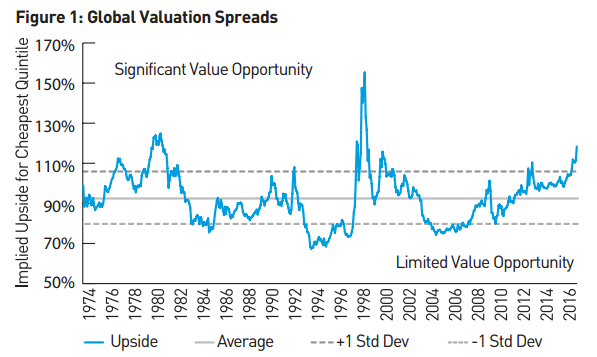

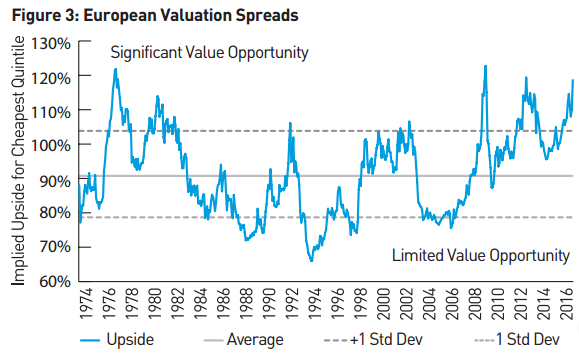
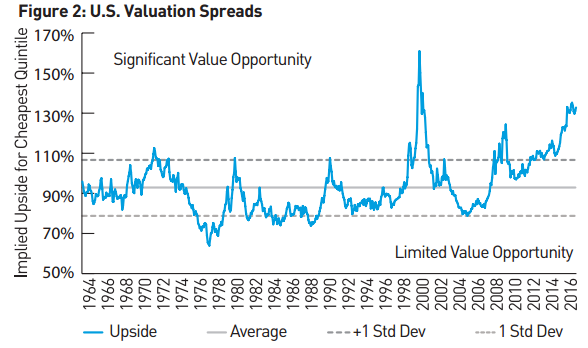
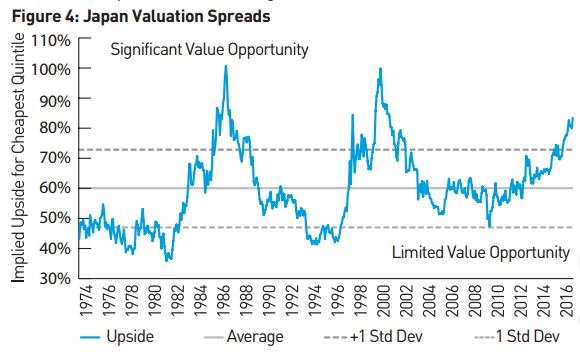
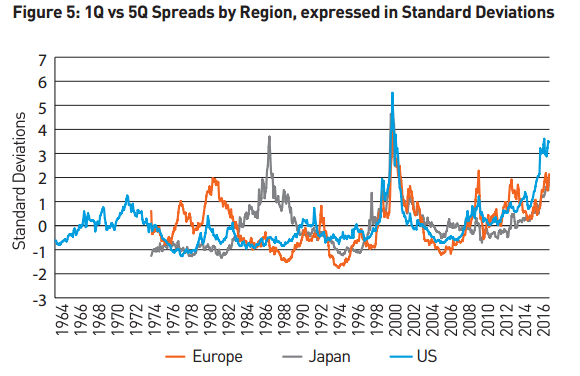
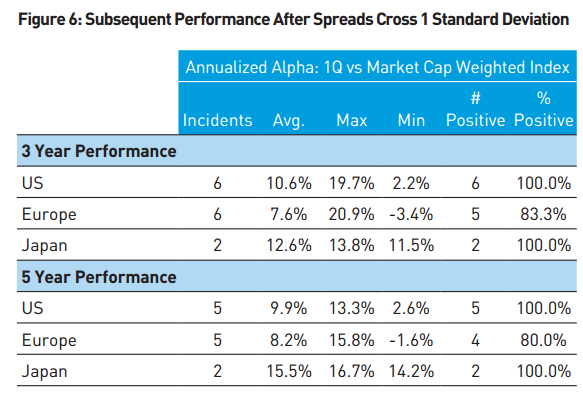


I check your website daily and it's great to see your post again.
Do you think comparing the cheapest and dearest stocks without looking into the quality/growth profile is not that meaningful? The cheap P/B stocks may stay cheap because of low ROE, etc. I don't think I have come across many stocks that have strong fundamentals but still priced cheaply. On the other hand I am not comfortable with the expensive defensives becoming more expensive either.
Do you have any views on BRK / MKL lately? Seems still cheap comparing to S&P and they're better than just buying a basket of low P/B names.
I recall a while ago you posted something on S&P 500 – the tough competitor that most of fund managers can't beat. I know things work until they don't, but the "smart beta" S&P 500 ETF that chooses stocks within the index seem doing better than S&P 500 on backtesting (equalweight, low vol, dividend aristocrat).
Cheers.
Hi,
Wow, thanks for that. Checking here daily?
It's true that this sort of analysis has it's limitations. Yes, it ignores quality, growth potential and things like that. But I do still think it is indicative of what's going on in the markets. I do like BRK and MKL and other quality names that are cheap (many financials), and there is no need to switch if you like what you own, of course.
But I do think this is interesting too. I myself haven't done anything to take advantage of this at this point, in a direct way… I don't own any Gotham funds.
Anyway, back to these charts. I remember seeing a study that showed mean reversion in businesses; high margin businesses go back to low-to-average margin, high return on cap goes to normal, high earnings growth peters out to low growth… negative to low growth goes up to average or high growth etc.
And the one constant was that analysts were unable to predict which companies would continue to grow and which would not.
The high valuation stocks had high earnings projections by analysts and low valuation stocks had low expectations. The analysts were wrong and high valuation stocks performed worse due to the growth estimate being wrong and growth not coming through.
And vice versa. Industries going through hard times had low valuation and low earnings growth expectations, and the stocks were cheap. When things normalized, earnings came back and stocks outperformed.
The conclusion was that since analysts were wrong and no better than random, it was just better to buy cheap stocks. Or something like that.
I've also seen a study that shows persistence of high return on capital and margins; great companies tend to stay great for a long time (KO, for example).
So it's a tricky situation. I do believe that both can be true. In a bigger portfolio, the first scenario probably plays out more, and for a select few stocks, the second scenario (persistence) may hold, but those will be few and far between.
As for smart beta, I haven't looked at them in any detail. I agree with you that they sort of work until they don't, particularly when they get so popular. So I would be cautious.
But as a value investor, it's hard to argue against just buying stuff cheap.
I know most value investors have terrible performance in the past few years but this may be a cyclical issue; all styles go through good and bad periods.
It feels like a great time to be a value investor. Well, it would be even better if the overall market was a lot cheaper, but I don't see it at this point as being bubbly expensive or dangerous at all.
Thanks for dropping by, and I'll try to post more this year…
Hi,
Thanks for posting again. Really enjoy your insights. One idea that might work along these lines is Cambria Global Value ETF (GVAL) it holds an index of cheap stocks in the cheapest global markets. It's been doing better lately. Disclosure, I don't have any affiliation, don't know anyone there, but I do own some. Wondering what you think about this, or similar funds. Thanks again!
Hi,
That may work, I suppose. I am not familiar with the fund or the company. One thing I would say is that I would sort of prefer investments in markets I know and am comfortable with. There is a place for other markets, particularly if they are cheap, but they do have other issues to think about, like the accounting rules etc. I would not necessarily be comfortable with valuations in markets I am not at all familiar with.
With Gotham, for example, you know they only deal with a universe with very good data, and the data is cleaned up themselves.
The above charts look at valuation dispersion within each of the market so you know mean reversion will work in those specific markets.
I don't know if the idea works if you do the same exercise with entire markets. GVAL has no exposure (or not much) in the U.S. and Japan, for example. What do the above charts look like for the specific markets that GVAL is invested in? I don't know. I would guess it's sort of similar, but you really don't know.
Anyway, if you are comfortable with the manager, the data they are using etc… then I suppose it may not be a bad idea.
It would not be my first choice, though…
good luck!
Thanks for the thoughtful response! Really appreciate you posting your thoughts. Wishing you well!
Hey- recently found your blog and enjoying it so far. I might be able to provide some insight into why allocators like market neutral and/or long/short hedge funds with tight net exposures. They tend to think of it as the beta plus alpha piece. So if you're looking at a hedge fund that runs say 100% long and 80% short consistently (180% gross by 20% net), your expected return is 20% of the market return plus whatever alpha you expect them to generate, minus fees. So if you think that beta component is gonna be super low (e.g. 20% * 4% market return = <1%), and you think your guys are super stock pickers (everyone does!) who can generate 500-700 bps of alpha per year, then your expected return is something like 1% (beta exposure) + 600 bps alpha – 1% management fee – 20% incentive fee (ideally over a hurdle rate). That gets you to something like 5% annual return, better than the 3% expected market return and with lower risk (they think). In other words, the relative attractiveness of "alpha only" (market neutral) strategies goes up when expected returns on beta strategies are super low, as many see today's environment.
The related point is that most big instutional allocators are in the risk management business rather than the return maximization business. If you have a 3-5% spending rate like an endowment, you can't afford big drawdowns (spending 3-5% after a 40% down = permanent impairment). So making market returns with half the volatility is a pretty good result.
Yeah, I get how the long/shorts usually work and the economics. I was more thinking about the guys that go short the market as a market call that it's expensive, and not a planned 120/80 type thing or whatever.
I was thinking more like the guys at BEARX, DRCVX, HSGFX and some others like that…
Plus if you just short a wide index like the S&P 500 index, you are locking in negative carry as interest rates are way lower than dividend yields. It takes a lot more to make that work…
Too funny .. as I was reading the first few paragraphs, my mind wandered and I found myself on Morningstar's GONIX page.
I've been a fan of Greenblatt's approach. I remember in H2 '14 and H1 '15, when his funds were doing well, he would always stress that his returns were highly cyclical, and that he fully expected his stellar performance to be more volatile in the future. He seemed almost fearful of his wild outperformance at launch, and was braced for the impact of the inevitable drawdown. And then it happened…
"Again, this doesn't apply to the macro hedge funds as they are active traders. They don't go short and just sit on it for years (well, some actually do that but still manage their risk well enough to make money). "
You seem to imply that most macro hedge funds by default make money vs dumb mutual funds. Most of those macro hedge funds have performed really badly for the past few years. Thus the well publicized closures (cf Fortress).
Good point. That's true. Most macro funds actually don't make money! But I was just trying to point out that it's not the same thing when, say, someone like Soros or Druckenmiller takes a short position in the S&P (and will actively trade it), versus some mutual fund that thinks stocks are overvalued and will just put on a huge short position and just sit on it for years…
Thanks for posting. I really enjoy your writing and I'm happy you will be posting more!
These charts are super interesting. I find myself at odds with the pundits constantly talking about the "market" being overvalued based on index multiples while I myself have a portfolio that probably has an average P/E of 12 along with a lot of special situation debt investments that look very attractive (20-30% IRRs). I found myself fully invested for the first time in January and I'm constantly frightened of a giant drawdown but not really sure if I should be building cash to have dry powder for what everyone seems to think is an inevitable crash.
Thanks. Yeah, if you are comfortable with what you own, I wouldn't worry about what the market is trading at. Remember to treat what you own as a piece of a business you own, not a piece of paper to trade. If you own a great restaurant that is always crowded and is making tons of money, are you going to rush to sell it when the S&P 500 P/E ratio gets to 20x? 30x? Of course not. If some dumb rich guy offers you 5x what you think it's worth, then of course, think about selling to him. But sell because it's a good price for YOUR business, not the S&P 500 index.
I know, that's hard to do.
As for cash on hand, you have to have exposure that you are comfortable with. No matter how cheap your stocks are, when things go down, everything can go down hard. If that is going to be too stressful, sell down to the sleeping level. But do it for the right reason; not because you think the market will or will not tank; it definitely will at some point…
Oh yeah, and some guy on CNBC said the other day (and it's someone who has been right alot and I respect) that the fair value of the S&P index should be around 14x P/E. I don't really get that at all. Sure, the market traded at 14-15x P/E on average the past 100 years or so. But then what was the average long term interest rate in the past 100 years? Certainly not where it is now.
Anyway, thanks for dropping by…
kk, glad to see you post again and great stuff as usual. Like that other commenter, I check this almost daily to see if there is an update and will often re-read older stuff. You should put a tracker on the site, you might be surprised!
Are you interested in SEB at this price?
Thanks. Yes, SEB is interesting but don't know what the dynamics are of the business in the near term. But as a long term hold, it should do well and I don't think it's expensive.
Interesting indeed. Thanks for sharing your insight and your gift in how you make your analysis sound so simple.
A question: Is there any source where one can track such valuation spread charts periodically? A source that publishes them as part of their research.
I guess Pzena is one candidate… and since you have not referred to any other, others less likely.
I don't know. The charts look like research that Sanford/Bernstein and Pzena did together for the report and may not be something that is published regularly.
Minor quibble with Pzena's graphs is the Y axis has different values and spreads for comparable data. Thank you for posting again. I find your perspective always educates.
For whatever it's worth, Greenblatt and Pzena are buddies from way back at Wharton undergrad in the 70s. Greenblatt is also a director of PZN.
Yes, I know. That's why I started to follow PZN in the first place. He is mentioned in the Genius book too, as the institutional fund manager that we average Joe's are supposed to have an advantage over.
Oops, sorry, I didn't word my comment very well, but my intended audience for that comment was actually your readers and not you. Wasn't trying to educate you, kk… I always assume you know more than me. 🙂
Anyone know a smaller minimum alternative to the Gotham funds? I work at an investment firm so most of my assets are invested there, but I have a Roth IRA that I can't put in the fund and doesn't hit Gotham's 250k minimum. I'm pretty constrained in what I can own due to compliance at work so I've been trying to brainstorm an index plus alternative. I'm not crazy about GVAL because there are big flaws in the Schiller PE in Europe right now due to bank dilution over the years (see here: http://www.philosophicaleconomics.com/2014/11/dilution-index-evolution-and-the-shiller-cape-anatomy-of-a-post-crisis-value-trap/)
this might be a bit of a hassle but I think if you invest directly with gotham funds they will let you invest below the minimum (and then you can transfer shares to your regular brokerage if you like)
I recently became depressed from the lack of posts and dropped down to checking weekly instead of daily. Now I'm seeing two new posts and it's like Christmas in August! So glad you're back at it. Seconding the comment about a tool to let us receive updates.
I wanted to follow up on your note about reversion to the mean regarding value spreads. This makes a lot of sense and is what all of us value investors intuitively believe about the world, but isn't it also possible that these spreads will remain very high for a long time or even increase because of the flow of money? I mean, money is only increasing its flow from active to passive strategies, which is kind of what's driving this, right? And if your argument is that the resulting inefficiency exposed here through value spreads will be corrected, I'm just curious what the catalyst will be. Is it that that the trend reverses from passive back to active, or that "passive" becomes a little less passive, or that all the active money flows into these stocks, thereby producing higher returns than passive for a few years, or something else?
Thanks a lot. This is my favorite thing to read on the internet by far by the way.
Thanks. Um, as far as catalysts go, I have no idea. They say value is it's own catalyst. It's true these spreads can remain wide for an extended period of time, but as long as you are sure of your longs, I wouldn't worry about it. Things will snap back eventually. The market has a way of correcting itself; for example, if something stays too cheap too long, the company may repurchase shares, or it may be taken out by private equity etc.
The 'when' is the hard part of investing, and also the part, I think, where most lose their money.
Anyway, these trends in the investment world come and go like fashion trends. If something goes on for a really long time, the other side can be big and long too, so there is that positive reward for waiting a long time…
The most likely catalyst would be a bear market similar to the 2000-02 experience. In the past couple of corrections over the past year, Gotham spreads have done very well for a brief time before giving it back. Note also in Figure 5, the spread briefly narrowing from 3.5 sigma to 3.0 sigma before returning to 3.5 sigma on this rally. For Gotham, the long book opportunity set is currently decent, but the short book opportunity set is outstanding. If you look at a similar fund like BPLSX that was around 20 years ago, you'll see that they lost 13% in 1999 but then gained 60% in 2000 and 25% in 2001. It was the tech bust bear market that turned the tide. The one complication here is that central banks are fighting the bear market tooth and nail with extraordinary interventions, i.e. trying to prop up the capital misallocation and postpone the day of reckoning as long as possible. Therefore, it's quite possible that it could go on longer than we expect. However, I would note that wage inflation is now percolating strongly, and that, plus the end of the credit cycle and the profits cycle, is what typically kills bull markets.
"The one complication here is that central banks are fighting the bear market tooth and nail with extraordinary interventions, i.e. trying to prop up the capital misallocation and postpone the day of reckoning as long as possible."
I hear this sentiment a lot, but I don't follow. You seem to imply that rates are currently lower than they otherwise would be and that this is driving people to overvalue stocks.
But what of the alternative? What if the central bank were NOT keeping the overnight lending rate low? Wouldn't that lead to much lower inflation expectations and, therefore, an even lower interest rate (because now investors, anticipating lower inflation or even outright deflation, would be willing to accept even lower returns on investment)? Would not the P/E ratio then climb even higher?
To quote Milton Friedman:
"As an empirical matter, low interest rates are a sign that monetary policy has been tight-in the sense that the quantity of money has grown slowly; high interest rates are a sign that monetary policy has been easy-in the sense that the quantity of money has grown rapidly. The broadest facts of experience run in precisely the opposite direction from that which the financial community and academic economists have all generally taken for granted."
https://assets.aeaweb.org/assets/production/journals/aer/top20/58.1.1-17.pdf
I was thinking of not just the ZIRP/low rate policy, but also the extensive QE, plus global central banks buying corporate debt and equities, etc. (ECB, SNB, BOJ, etc.). Lower rates do not always and everywhere imply higher equity valuations–see Japan over the past 25 years–two bear markets of 60% each in a ZIRP environment. If the economy enters a cyclical downturn, and bad debt goes bad, you get a negative feedback loop, crashing profits, much tighter credit conditions, liquidation of leveraged positions, etc.
In the US, rates were much lower in 2002-03 than in 1999-2000, but we certainly didn't have higher equity valuations in 2003 than in 2000.